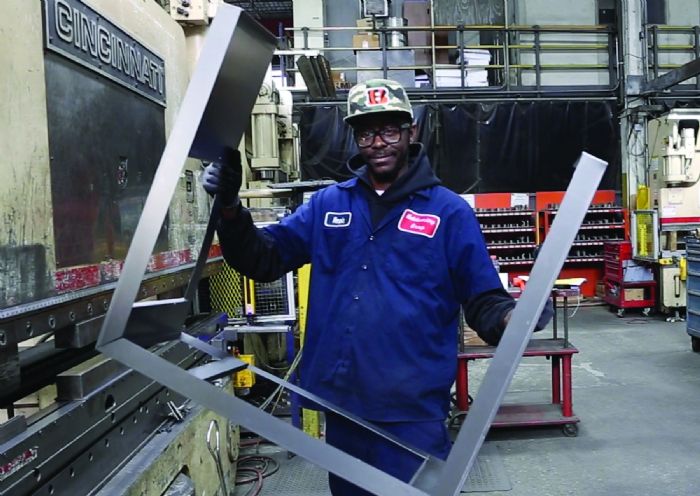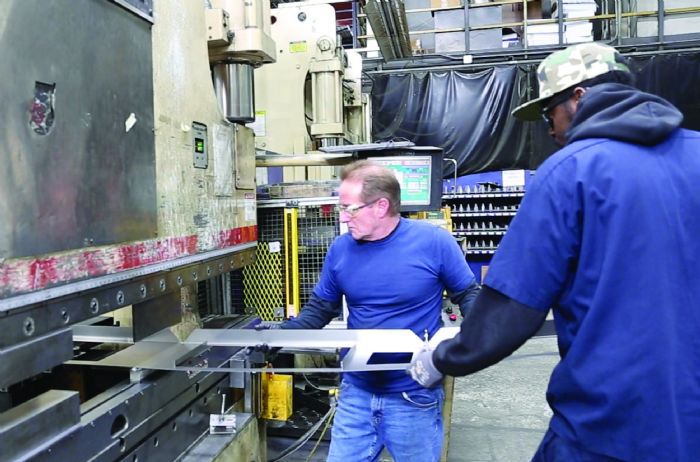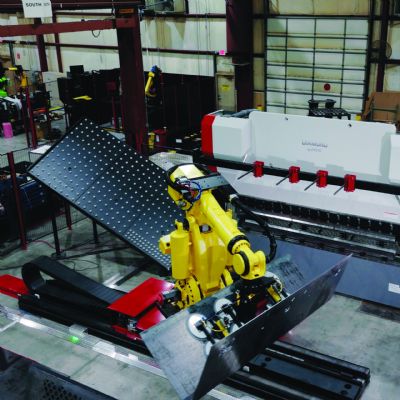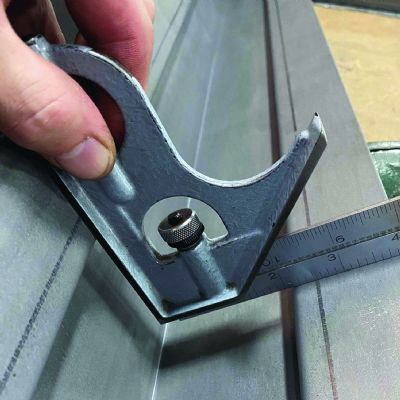 Watts, who immediately sought a way to even-out the pay gap in a quantifiable way, felt that handing out merit increases would create additional resentment, unless everyone understood the justification for their pay grades. After discussing the issue with National Institute of Metalworking Skills (NIMS) senior advisor Cathy Metcalf, Watts immediately felt that NIMS could help.
Watts, who immediately sought a way to even-out the pay gap in a quantifiable way, felt that handing out merit increases would create additional resentment, unless everyone understood the justification for their pay grades. After discussing the issue with National Institute of Metalworking Skills (NIMS) senior advisor Cathy Metcalf, Watts immediately felt that NIMS could help.
“I understood what they were going through,” recalls Metcalf. “We’ve helped many companies with the same issue, so I knew that we could help them.”
A Five-Step OJT Process
|
If so, PMA has your back, thanks to the recent introduction of new courses to its METALFORM EDU online training platform. To develop the new press brake operator courses, PMA partnered with subject-matter experts to review and update its existing press-brake training materials. The result: 12 new courses with topics covering tooling, gauging, safeguarding, proper operation, measuring devices and more.
“PMA is excited to roll out the new press brake courses for the metal forming industry,” says Connie King, PMA workforce development director. “We look forward to continuing to expand the METALFORM EDU library with additional modules for key industry jobs and skill sets."
One area covered by the courses is the basic machine types and where they’re best applied by metal fabricators. For insight, we spoke with one of the primary content contributors to the courses, Dean Phillips. Now a sales engineer with press-control manufacturer Link Systems, Phillips previously spent over a decade working for press brake manufacturers, designing and supporting their sheet metal fabricator customers.
“Fabricators should understand the fundamental differences between older-style mechanical press brakes, tried and true and still in use today,” says Phillips, “as well as the more popular and advanced hydraulic up- and down-acting machines, hydromechanical press brakes, and the newest machines on the market—servo-electric, which continue to grow in popularity. The courses we developed for PMA certainly do that.”
Hydraulic down-acting hydraulic machines are the most-used press brakes, Phillips says, equipped with a cylinder on each side of the machine. A hydraulic press brake provides the ability to dwell at bottom and control ram speed, not possible with mechanical models. Typically, the machine’s cylinders are synchronized via an electrohydraulic circuit to ensure positioning accuracy and repeatability. The disadvantage, says Phillips: Locating a tool set to one side of the bed can reduce the available tonnage.
“For example,” he explains, “a 200-ton machine provides 100 tons under each cylinder, so if you’re tooling is located closer to one side of the brake than the other, you’re not able to generate the full 200 tons.”
Also popular are hydromechanical press brakes that combine the versatility of a hydraulic machine with an added mechanical advantage, which compared to a hydraulic press enables the use of smaller hydraulic cylinders while generating the same amount of tonnage. “Smaller cylinders are less expensive,” shares Phillips, “and easier to maintain.” Also noteworthy: Most hydromechanical models are not synchronous machines, instead relying on independent control of the left and right cylinders.
Hydromechanical models come in two basic styles, with the cylinder positioned either laterally or vertically. Both machine styles often will employ a pre-crowned bed to adjust the force curve during forming. “This works fine for fabricators forming longer, nearly full-length parts,” Phillips says, “but when forming small parts or off-center tooling setups, quality may be inconsistent as tonnage can vary at different points along the bed.” In these cases, look for machines with dynamic CNC hydraulic crowning.
Most recently introduced to the market are servo-electric press brakes, which use electric motors to drive the ram. To produce motion, motors can be attached directly to the drive screw or can drive belts and pulleys. These machines provide numerous advantages in term of stroke control, accuracy and repeatability—and of course they eliminate the need for hydraulic circuits. However, they’re somewhat limited in terms of tonnage (300 tons or so) and, therefore, their capacity to bend higher-strength materials and thicker workpieces. Phillips also notes that these machines often are easier for newer press brake operators to learn, “also true for hydraulic press brakes with modern, ‘smart’ controls,” he adds, “that manage most if not all of the bending process and require very little if any operator knowledge about how materials form.”
Also available are hybrid machines combining a servo-electric drive with a hydraulic power-generating system. “These are preferred primarily for air bending rather than bottoming or coining,” Phillips says.
How does a fabricator decide which style of press brake is right for its applications? “If you’re doing multiple tool setups across the bed, that can start to eliminate the hydromechanical models because of the number of pivot points and inaccuracies,” Phillips says. “In these cases, a synchronous hydraulic or a servo-electric machine is the best choice. Fabricators performing mostly basic, simple bending operations generally can make do with simpler machines, but in most other cases you’ll need a more modern and capable machine. And, most shops today also seek machines equipped to handle faster tool change “and suppliers have added automation to quicken changeovers and improve throughput. More-efficient material and tool handling holds the key to optimum press-brake throughput.
“When talking about training operators and calling them press brake operators,” Phillips continues, “this can add to confusion because operators may be trained on one type of machine but would have limited experience on the other styles. Consequently, it’s important to develop standard assessments for your specific machines.”—Brad Kuvin
|
NIMS, Fairfax, VA, helps companies enhance their on-the-job-training (OJT) by taking them through a five-step employer-engagement process to help discover their ideal training behaviors and learn how to apply what NIMS refers to as smart training solutions (STS). This is a framework of training methods based on three pillars: smart standards, smart performance measures and smart training principles. The goal: build a bridge between educators and employers, and help firms modernize their training to keep pace with technology.
Many people responsible for training, says NIMS executive director Montez King, begin by defining the training materials associated with a particular job—a necessary step, but not necessarily the first step.
“Many employers do not provide enough deliberate and targeted training for their employees,” King says, “and instead rely on time and chance for learning—learning by osmosis, if you will. This method of learning introduces people to new workplace tasks with enough direction to operate, or do what they are told to do. However, all of the knowledge and skills required to make decisions, configure or set up these activities are learned haphazardly over time.”
The problem, King explains: Trainers become stuck between the pressure of completing their own work and shooting from the hip when transferring their skills and knowledge. This conflict results in training for some and no training for others, with zero confidence that in reliability of the training.
“We seek to help companies identify the tasks and workplace activities ideal for training, and then create opportunities to train within the natural flow of work,” explains King. “The average employer will use less than 10 percent of an employee’s time on the job to provide structured training, the rest spent on production. As a result, employers must make decisions about when, how and how often to dedicate an employee’s time to training.”
MWG’s Pay Scale Based on Ability and Achievement
When NIMS began to work with MWG on its press brake-training program and pay-scale challenges, it sought a measurable way to bring everyone in the department to the same skill and pay level.
“We wanted pay to be based on ability and achievement,” says Mondillo.
NIMS started by working with MWG to define the duties necessary to ensure that the department would perform productively, daily. It organized duties into roles based on responsibilities, using these standards to drive the development of all training materials. For MWG, this process defined a skills hierarchy that featured three specific roles, each with a defined pay scale to eliminate subjectivity:
- Entry-level pedal pusher
- Mid- to advanced-level press brake operator
- Leadership-level press brake supervisor.
At this point, an evaluator was selected and trained to review employee performance and assign roles based on the ability to perform the duties listed. Pedal pushers, for example, stay at this level if they can perform some but not all of the duties within the role. They know exactly what they need to learn to become fully credentialed pedal pushers, and acquiring those skills require that they find opportunities within the regular production cycle to learn.
“The trainer and the trainee know the production schedule,” says Mondillo. “They agree ahead of time that when something comes up during production, the trainer can stop making parts and move over to the trainee to teach or observe.”
Basing training on opportunity is a big productivity booster, ensuring that training occurs within the natural flow of the production cycle and that trainers are pulled away from their tasks only when they’re teaching, rather than losing an entire day of work teaching skills out of context.
Onward and Upward
When the trainer deems that a pedal pusher has become fully qualified, the pedal pusher either can stay in that role or begin acquiring the skills necessary to move up to press brake operator. The same applies for a press brake operator wanting to become a supervisor.
“With this structure, our long-time press brake operators go through the same evaluation,” explains Mondillo. “However, instead of staying at the entry-level role, they can progress to the other roles.” Mondillo adds that by instituting this new program and as employees have graduated to become fully qualified press brake operators, the company now has a quantifiable reason to increase their pay scale.
However, what happens when a trainee comes to the press brake department from other departments with higher pay rates?
“They don’t get pay cuts, that would not be fair,” says Mondillo. “They just understand that they won’t be eligible for increases until they are fully qualified for certain roles.
“That’s the great thing about the NIMS STS program,” Mondillo continues. “Now we have a process that we can take people through, so that they understand how to get from point A to point B.”
Discrepancies, Bottlenecks Solved
MWG’s new NIMS STS training framework has helped to solve training bottlenecks and pay-scale discrepancies. The solution also makes it easier for management to understand exactly what’s happening on the floor, according to Mondillo.
“I have data that I can show management and explain how well our training is going based on the mastery of the tasks within each role,” he says. “Everything was built with the goal of being measurable, which means that we also can measure exactly how far along people are with their training.”
Mondillo also emphasizes that the press brake team members promote the training and standards among themselves, viewing the program as an opportunity to earn better pay for better skills, “and they like having a clear path to follow,” he says. “Another aspect of this program that the team likes: They earn industry-recognized certification when they master certain roles.”
“The company mindset has flipped from one of uncertainty to one of assurance,” adds King. “Now, managers and trainers know exactly what needs to happen to get an employee up to speed. The company’s win: We have people that can do the work. The employees’ win: Wow, I get something that I can use for my entire career.” MF
Article provided by NIMS; www.nims-skills.org; 844/839-6467.
Industry-Related Terms: Air Bending,
Bed,
Bending,
Bottoming,
Center,
CNC (Computer Numerical Control),
Forming,
Hardware,
Hydraulic Press,
LASER,
Pallet,
Plate,
Ram,
Scale,
StrokeView Glossary of Metalforming Terms
See also: Link Systems
Technologies: Bending
 For the Metalworking Group (MWG), a sheet metal and plate fabricator based in Cincinnati, OH, this question has been a hot topic for some time. “We’ve found over the years that we can find pretty good machinists,” says Bill Mondillo, MWG’s safety and facilities manager. “Where we’ve really struggled is with press brake operators.”
For the Metalworking Group (MWG), a sheet metal and plate fabricator based in Cincinnati, OH, this question has been a hot topic for some time. “We’ve found over the years that we can find pretty good machinists,” says Bill Mondillo, MWG’s safety and facilities manager. “Where we’ve really struggled is with press brake operators.”






 Watts, who immediately sought a way to even-out the pay gap in a quantifiable way, felt that handing out merit increases would create additional resentment, unless everyone understood the justification for their pay grades. After discussing the issue with National Institute of Metalworking Skills (NIMS) senior advisor Cathy Metcalf, Watts immediately felt that NIMS could help.
Watts, who immediately sought a way to even-out the pay gap in a quantifiable way, felt that handing out merit increases would create additional resentment, unless everyone understood the justification for their pay grades. After discussing the issue with National Institute of Metalworking Skills (NIMS) senior advisor Cathy Metcalf, Watts immediately felt that NIMS could help.

